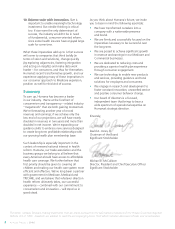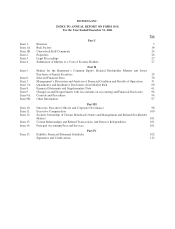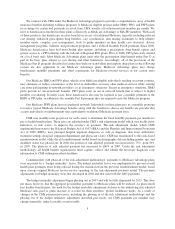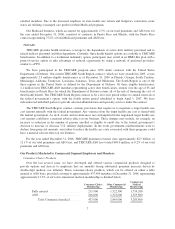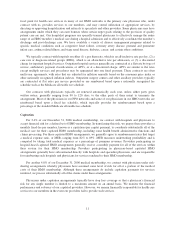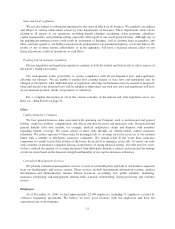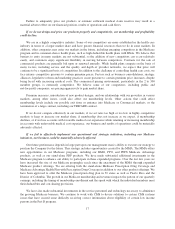Humana 2006 Annual Report Download - page 20
Download and view the complete annual report
Please find page 20 of the 2006 Humana annual report below. You can navigate through the pages in the report by either clicking on the pages listed below, or by using the keyword search tool below to find specific information within the annual report.These products are often offered to employer groups as “bundles”, where the subscribers are offered various
HMO and PPO options, with various employer contribution strategies as determined by the employer.
Paramount to our consumer-choice product strategy, we have developed a group of innovative consumer
products, styled as “Smart” products, that we believe will be a long-term solution for employers. We believe this
new generation of products provides more (1) choices for the individual consumer, (2) transparency of provider
costs, and (3) benefit designs that engage consumers in the costs and effectiveness of health care choices.
Innovative tools and technology are available to assist consumers with these decisions, including the trade-offs
between higher premiums and point-of-service costs at the time consumers choose their plans, and to suggest
ways in which the consumers can maximize their individual benefits at the point they use their plans. We believe
that when consumers can make informed choices about the cost and effectiveness of their health care, a
sustainable long term solution for employers can be realized. Smart products, which accounted for approximately
63% of enrollment in all of our consumer-choice plans as of December 31, 2006, are only sold to employers who
use Humana as their sole health insurance carrier.
Some employers have selected other types of consumer-choice products, such as, (1) a product with a high
deductible, (2) a catastrophic coverage plan, or (3) ones that offer a spending account option in conjunction with
more traditional medical coverage or as a stand alone plan. Unlike our Smart products, these products, while
valuable in helping employers deal with near-term cost increases by shifting costs to employees, are not
considered by us to be long-term comprehensive solutions to the employers’ cost dilemma, although we view
them as an important interim step.
HMO
Our commercial HMO products provide prepaid health insurance coverage to our members through a
network of independent primary care physicians, specialty physicians, and other health care providers who
contract with the HMO to furnish such services. Primary care physicians generally include internists, family
practitioners, and pediatricians. Generally, the member’s primary care physician must approve access to certain
specialty physicians and other health care providers. These other health care providers include, among others,
hospitals, nursing homes, home health agencies, pharmacies, mental health and substance abuse centers,
diagnostic centers, optometrists, outpatient surgery centers, dentists, urgent care centers, and durable medical
equipment suppliers. Because the primary care physician generally must approve access to many of these other
health care providers, the HMO product is considered the most restrictive form of a health benefit plan.
An HMO member, typically through the member’s employer, pays a monthly fee, which generally covers,
together with some copayments, health care services received from, or approved by, the member’s primary care
physician. We participate in the Federal Employee Health Benefits Program, or FEHBP, primarily with our
HMO offering in certain markets. FEHBP is the government’s health insurance program for Federal employees,
retirees, former employees, family members, and spouses. For the year ended December 31, 2006, commercial
HMO premium revenues totaled approximately $2.0 billion, or 9.6% of our total premiums and ASO fees.
PPO
Our commercial PPO products, which are marketed primarily to employer groups and individuals, include
some types of wellness and utilization management programs. However, they typically include more cost-sharing
with the member, through copayments and annual deductibles. PPOs also are similar to traditional health
insurance because they provide a member with more freedom to choose a physician or other health care provider.
In a PPO, the member is encouraged, through financial incentives, to use participating health care providers,
which have contracted with the PPO to provide services at favorable rates. In the event a member chooses not to
use a participating health care provider, the member may be required to pay a greater portion of the provider’s
fees.
8


